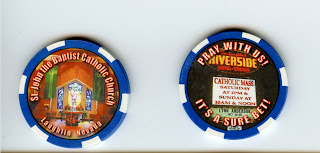Saint of the day May 04
Saint of the day May 04
Bl. Carthusian Martyrs, 1540 A.D. English monks of the Carthusian Order put to death by King Henry VIII because of their continued allegiance to the pope and the authority of the Holy See. These martyrs, eighteen in all, were beatified in 1886.
St. Augustine Webster, 1535 A.D. One of the Forty Martyrs of England and Wales canonized in 1970. Augustine was a Carthusian prior of the Charterhouse at Axholme, England. He was arrested in London and martyred at Tyburn.
St. John Houghton, 1535 A.D. Protomartyr of the English Reformation. A native of Essex, he served as a parish priest after graduating from Cambridge. He then became a Carthusian and the prior of the Carthusian Charterhouse of London. As an opponent of King Henry VIII’s Acts of Succession and Supremacy, he was arrested with other Carthusian but was released temporarily. He then refused to swear to the Oath of Supremacy, the first man to make this refusal. Dragged through the streets, he was executed at Tyburn with four companions by being hanged, drawn, and quartered. Parts of his remains were put on display in assorted spots throughout London. Pope Paul VI canonized him in 1970 as one of the Forty Martyrs of England and Wales.
St. John Payne, 1582 A.D. Also John Paine. An English martyr. Payne was born at Peterborough, England, and was possibly a convert. In 1574, he departed England and went to Douai, where he was ordained in 1576. Immediately thereafter, he was sent back to England with St. Cuthbert Mayne. His labors met with considerable success, but he was arrested within a year. Released by English authorities, he departed the island but came back in 1579. While staying in Warwickshire on the estate of one Lady Petre, he was arrested once more after being denounced by John Eliot, a known murderer who made a career out of denouncing Catholics and priests for bounty. Imprisoned and tortured in the Tower of London for nine months, he was finally condemned to death and hanged, drawn, and quartered at Chelmsford. He is one of the Martyrs of England and Wales canonized by Pope Paul VI in 1970.
St. Richard Reynolds, 1169 A.D. Brigettine martyr of England and one of the Forty Martyrs of England and Wales. He was born in Devon, England, in 1492 and was educated at Cambridge. In 1513, he entered the Brigettines at Syon Abbey, Isleworth. When King Henry VIII demanded royal oaths, Richard and others opposed the monarch. They were executed at Tyburn. Richard was canonized in 1970.
St. Robert Lawrence, 1535 A.D. One of the Forty Martyrs of England and Wales. After joining the Carthusians, he served as prior of the Charterhouse at Beauvale, Nottinghamshire, at the time when King Henry VIII of England broke with Rome and launched the Dissolution of the Monasteries. Robert went with St. John Houghton to see Thomas Cromwell, who had them arrested and placed in the Tower of London. When they refused to sign the Oath of Supremacy, they were cruelly tortured and executed at Tyburn, making them among the first martyrs from the order in England. Beatified in 1886, Robert was canonized by Pope Paul VI with the other martyrs in 1970.
The Forty Martyrs of England and Wales. A famed group of Catholic martyrs who were put to death for the faith and who received canonization on October 25, 1970, by Pope Paul VI. The saints belonging to this group are covered in individual entries, but the members are: Alban Roe (January 21), Alexander Bryant (December 1), Ambrose Barlow (September 11), Anne Line (February 27), Augustine Webster (May 4), Cuthbert Mayne (November 29), David Lewis (August 27), Edmund Arrowsmith (August 28), Edmund Campion (December 1), Edmund Gennings (December 10), Henry Morse (February 1), Henry Walpole (April 7), John Almond (December 5), John Boste (July24), John Houghton (May 4), John Jones (July 12), John Kemble (August 22), John Lloyd (July 22), John Payne (April 2), John Plessington (July 19), John Rigby (June 19), John Roberts (December 9), John Stone (May 12), John Southworth (June 27), John Wall (August 22), Luke Kirby.
The Forty Martyrs of England and Wales comprise a group of Catholic men and women who were executed for treason and related offences in the Kingdom of England between 1535 and 1679. Many were convicted at show trials or even without a trial. All were subjected to the religiously oppressive regimes of the Tudor and Stuart periods. They are considered by the Catholic Church to be Christian martyrs and were canonized on 25 October 1970 by Pope Paul VI. Feastday May 4
St. Florian, was an officer of the Roman army, who occupied a high administrative post in Noricum, now part of Austria, and who suffered death for the Faith in the days of Diocletian. His legendary "Acts" state that he gave himself up at Lorch to the soldiers of Aquilinus, the governor, when they were rounding up the Christians, and after making a bold confession, he was twice scourged, half-flayed alive, set on fire, and finally thrown into the river Enns with a stone around his neck. Feastday May 4
ST. ANTONINA OF NICEA, MARTYR, saint Antonina, martyr, who was cruelly tortured and tormented with various tortures, three days hanging, then imprisoned for two years and, finally, under Governor Prisciliano, and by the confession of his faith in God, was burned alive. May 4
The Eighty-five Martyrs of England and Wales are a group of men who were executed on charges of treason and related offences in the Kingdom of England between 1584 and 1679. They are considered martyrs in the Roman Catholic Church and were beatified on 22 November 1987 by Pope John Paul II. Feastday May 4




Comments
Post a Comment